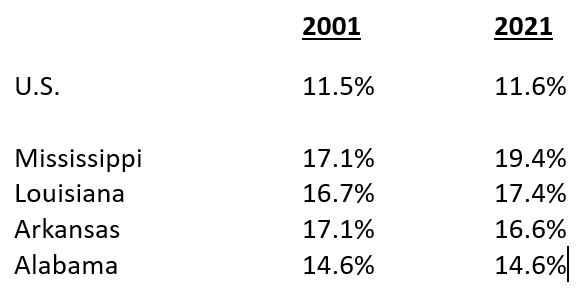In 2001, the U.S. Commission on Civil Rights published its long-awaited report, Racial and Ethnic Tensions in American Communities: Poverty, Inequality, and Discrimination Volume VII: The Mississippi Delta Report. This groundbreaking report was the product of four years of investigation and, for a moment, shocked the nation. It described abject poverty throughout the region.
Yesterday, 22 years later, the Bureau of Labor Statistics released data on unemployment in U.S. counties from 2002 to 2022. The BLS report focused on the Mississippi Delta, the same area studied by the Civil Rights Commission. Although employment in the nation grew by 17.8% during the period, employment in the Delta dropped 0.6%, the result being that the Mississippi Delta is now, and has been since 2001, the poorest region in America. Why is this?
First, some background.
The Lower Mississippi Delta region is an enormous area encompassing portions of seven states: Arkansas, Illinois, Kentucky, Louisiana, Mississippi, Missouri, and Tennessee. It begins in southern Illinois and ends at the southeastern tip of Louisiana. The Delta is composed of 219 counties and is home to 8.3 million people, the majority of whom are black, and their current socioeconomic condition, which has been the subject of numerous studies, can generally be characterized charitably as one of limited economic resources, inadequate employment opportunities, insufficient affordable housing, and poor quality public schools.
The region’s unique history of slavery carries with it debilitating legacies: the sharecropping system, Jim Crow laws, the concentration of wealth in the hands of a minority white population, the political disenfranchisement of blacks, and the nearly total social segregation of the races. All of this has been well documented and is generally viewed as the most significant factor in the region’s present position as the poorest section of the nation based on virtually every socioeconomic measurement.
The Delta, which when the Civil Rights Commission was studying the area was known as a “Third World Country in the heart of America,”¹ was an agricultural powerhouse in the 19th century that was left behind by the industrial revolution. For all the reasons listed above, the unemployment and poverty we know today followed.
The preponderance of poverty lies in four states: Mississippi, Louisiana, Arkansas, and Alabama, and the poverty rates in these four Delta states are about the same or have gotten worse since the Civil Rights Commission’s report.
Notwithstanding these statewide numbers, the poverty rate in most Delta counties is 30 to 40 percent. The predominant demographic is the Black population.
Let’s focus on Mississippi. The percentage of Black families with incomes below the poverty level ranges from 46.4% in Washington County to 68% in Tunica County. In stark contrast, the poverty rates for white families in the same area range from Holmes County’s 7.2% to Tallahatchie County’s 14.9%.
This is an ongoing tragedy, and the reasons for it are legion. However, political ideology is a big one. Historically, governmental administrations in the four cited states have been firm in their resolve to go it alone, rather than asking for and accepting federal assistance. You can still hear echoes of the state’s rights arguments of the civil war period.
Mississippi’s governor is Republican Tate Reeves, who has refused expansion of Medicaid, along with a number of other federal programs. His predecessor, Republican Phil Bryant, offered incentives to attract two tire manufacturing plants — one is open, the other being built. Neither is in the Delta.
But, while the Delta region continues to labor, the overall Mississippi economy seems to be in a slight rebound for three primary reasons, one of them offering some benefit to the people in the Delta:
First, there is the growth of the Dockside Casino industry, the entirety of which is in the Delta. In 1990, the state passed a law allowing dockside casinos along the Mississippi River and the Gulf Coast. Today, there are 38 casinos in Mississippi, employing nearly 33,000 people. Most of the casinos are in impoverished Tunica County. The trouble is, while casinos have brought employment to many, other industries, such as manufacturing, have reduced employment.
Second, Mississippi’s agricultural industry is once again booming. According to the U.S. Department of Agriculture, the state now ranks in the upper tier of the nation for agriculture, with producers raising and and selling $6.2 billion in crops and livestock in 2019. In 2021, the Tyson company invested $61 million to expand its operations in the Magnolia state.
Third, there is the significant economic impact generated by the Infrastructure Investment and Jobs Act of November, 2021. The Jobs Act was bipartisan, with 19 Republican senators voting for it, including one of Mississippi’s—Roger Wicker. The Act will bring $4.6 billion to the state. Because of this, construction jobs in the state are on a dramatic rise. Mississippi’s other Senator, Cindy Hyde-Smith, voted against the bill, because of its cost. She said it was “a bridge too far.” Frankly, as a Senator from the poorest state in the nation, perhaps Hyde-Smith should take whatever she’s offered and say, “Thank you.”
Mississippi, especially its Delta region, has a long way to go, and I’m sure its citizens are sick and tired of being the nation’s economic bottom-of-the-birdcage. Yet, in some pockets, things are improving thanks to some calm and rational people. We need more of them.
In particular, we need a collective and constructive approach to helping all the rural southern areas in the Delta. One positive step Mississippi could take would be to expand Medicaid, which would provide significant aid to 200,000 Mississippians who don’t have health insurance, because they can’t afford it, 70% of whom live in the Mississippi Delta.
_____________________
¹ Michael Parfit, And What Words Shall Describe the Mississippi, Great Father of Rivers, Smithsonian, February 1993, p. 36.


